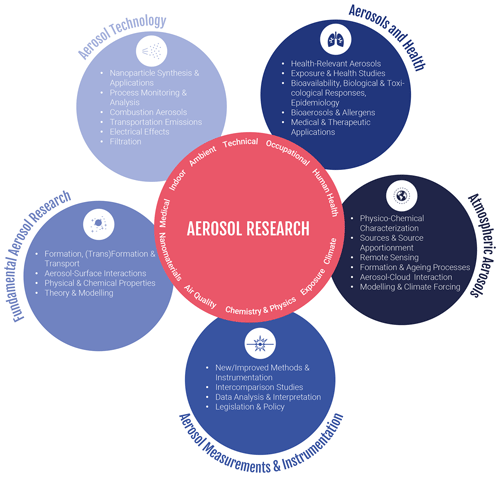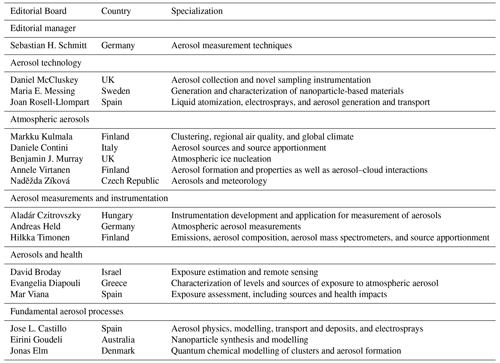the Creative Commons Attribution 4.0 License.
the Creative Commons Attribution 4.0 License.
Editorial: Aerosol Research – a new diamond open-access journal covering the breadth of aerosol science and technology
Aladár Czitrovszky
Andreas Held
Annele Virtanen
Astrid Kiendler-Scharr
Benjamin J. Murray
Daniel McCluskey
Daniele Contini
David Broday
Eirini Goudeli
Hilkka Timonen
Joan Rosell-Llompart
Jose L. Castillo
Evangelia Diapouli
Mar Viana
Maria E. Messing
Markku Kulmala
Naděžda Zíková
Sebastian H. Schmitt
- Article
(1263 KB) - Full-text XML
- BibTeX
- EndNote
This editorial is dedicated to the memory of Astrid Kiendler-Scharr. Astrid laid the foundation for Aerosol Research, and the journal would not have become a reality without her commitment. Astrid had a clear vision for the journal, but she unfortunately passed away shortly before the launch of the journal. We would like to honour her memory by fulfilling her vision of the journal.
Aerosol science is a rapidly growing field that intersects with a broad range of scientific disciplines, including atmospheric science, environmental health, and materials science. Aerosols play a critical role in the Earth's atmosphere, affecting climate, air quality, and human health. Furthermore, aerosol technology has numerous industrial applications, from drug delivery and materials science to air filtration and combustion engineering. To advance our understanding of aerosols and their impacts, a new journal has been launched that integrates all aspects of research on aerosol technology and science. This is also the first diamond open-access journal that covers the full spectrum of aerosol science and technology.
Aerosol Research is an open-access, non-profit international scientific journal dedicated to the dissemination and scientific discussion of high-quality original aerosol research. As part of the Copernicus Publications family of journals, Aerosol Research builds on 20 years of multi-stage open-access publishing, with detailed article-level metrics and professional copy-editing. Studies on all aspects of aerosol-related research are welcome, from new measurement techniques to the transmission of disease and from atmospheric particulate matter to material science and technology (see Fig. 1). While the applications of aerosol science are diverse, Aerosol Research publications focus on aerosol particles, including their formation, evolution, transport, and sampling as well as the characterization of their physical, chemical, and biological properties. The journal publishes theoretical, numerical, and experimental investigations in both fundamental and applied aerosol science. “Research articles” and “Reviews” are considered for peer-reviewed publication as well as invited “Opinion” contributions.
Aerosol Research covers the full breadth of aerosol-related topics. The journal is structured into five broad subject areas based on the European Aerosol Assembly (EAA) working groups. This is an international journal, initiated by European societies through the EAA, which encourages submissions from all countries. An overview of the topics currently covered in Aerosol Research can be seen in Fig. 1. These topics are flexible, and new topics will be added as new areas of aerosol research are identified.
3.1 Aerosol technology (AT)
AT focuses on research and development in areas such as emission control, filtration and powder technology, advances in functional nanomaterials, and Industry 4.0 systems. Potential specific subtopics can be material synthesis, nanoparticle synthesis and application, upscaling from lab to industrial production via aerosol processing, filtration and gas-cleaning technologies, charging and electrical effects, electrosprays, industrial and high-temperature aerosols, and combustion aerosols and transportation-related emission control.
3.2 Atmospheric aerosols (AAs)
The AAs subject area covers a wide variety of research topics, such as the physical, chemical, and optical characterization of atmospheric particulate matter (PM), atmospheric aerosols (including remote sensing) and their mimics, studies of aerosol sources and source apportionment, kinetic and mechanistic investigations on the formation and ageing of atmospheric aerosols, studies of aerosol–cloud interaction and climate impact, atmospheric aerosol transport and deposition investigations, and aerosol modelling on the local to global scale. Research works should provide better insight, new aspects, and knowledge on the properties and lifecycle of atmospheric aerosol particles that are of potential interest to the broad readership of the journal. Contributions from field measurements as well as aerosol chamber, laboratory, and modelling studies are welcome.
3.3 Aerosol measurements and instrumentation (AMI)
AMI covers all aspects related to the measurement of aerosol and their properties as well as the evaluation of the resulting data. These techniques cover a wide range of applications, including workplace, process, and atmospheric aerosols. The main topics include studies on, for example, sampling and measurement of aerosols, development of new or improved measurement approaches, data analysis techniques, legislation, and policy.
3.4 Aerosols and health (AH)
AH addresses both adverse health effects of aerosols as well as their therapeutic uses. Understanding the relationships between exposure and effects is key to understanding and mitigating health impacts. The main topics covered include exposure assessment and sources, exposure assessment techniques, respiratory-tract processes, microenvironments indoors and at workplaces, health-relevant aerosol characteristics, and health responses from toxicology to epidemiology. This topic promotes interdisciplinary contributions to create synergies between fields such as physics, chemistry, medicine, biology, pharmacy, toxicology, epidemiology, exposure science, and engineering.
3.5 Fundamental aerosol research (FAR)
FAR targets processes that govern the physical and chemical properties of aerosols that are required for the prediction of macroscopic aerosol behaviour, such as nanoparticle characteristics, optical properties, surface properties, aerosol formation (nucleation) and growth, molecular dynamics, agglomeration, fragmentation, and filtration. Contributions will address fundamental processes, for example, in the context of aerosol chemistry, aerosol modelling, and aerosol physics.
Aerosol Research is published by Copernicus Publications and offers an interactive, transparent public peer-review discussion process. After a rapid editorial screening, the manuscript is published as a preprint in a discussion forum. The discussion phase is open to the public for 6 weeks, during which the preprint can be commented on by the invited referees (minimum of two required), authors, and other members of the aerosol community. All interested aerosol researchers are encouraged to participate in the open forum to stimulate the discussion. The authors are encouraged to rapidly reply to comments from the community to facilitate the discussion. The final editorial decision will be based on both the comments from the referees and the community as well as the replies from the authors. This format ensures that, in cases where there are no comments from the scientific community, a traditional peer-review process is still assured.
To ensure transparency and fairness in the publication process, it is required that all authors disclose their contributions to the research presented in their manuscripts. The CRediT (Contributor Roles Taxonomy) framework is recommended to specify each author's contribution to the study.
Aerosol Research has assembled a diverse editorial board, both with respect to age, gender, affiliations, and specializations (see Table 1). In addition, the editorial board represents several of the EAA societies across Europe. It consists of several scientists within each of the journal topics (AT, AAs, AMI, AH, and FAR) and covers all aspects of aerosol science and technology. The editorial board strives to provide a welcoming and inclusive environment for all researchers, regardless of their backgrounds, identities, or affiliations. The journal is open for new editorial members of all ages, genders, and countries.
The ambition is to establish Aerosol Research as a high-quality, esteemed journal in the field. This can only be achieved with support from the community, who will serve as referees, and with management of the submission process by volunteering editors. High-quality submissions are encouraged from all authors within all aspects of aerosol science at https://www.aerosol-research.net/ (last access: 30 June 2023).
JE: conceptualization, investigation, writing – original draft, project administration, and supervision; JE, BM, EG, SS, AC, AH, AV, DM, DC, DB, HT, JR-L, JLC, LD, MV, MM, MK, and NZ: writing – review and editing; AK-S and SS: visualization and funding acquisition.
Publisher’s note: Copernicus Publications remains neutral with regard to jurisdictional claims in published maps and institutional affiliations.






